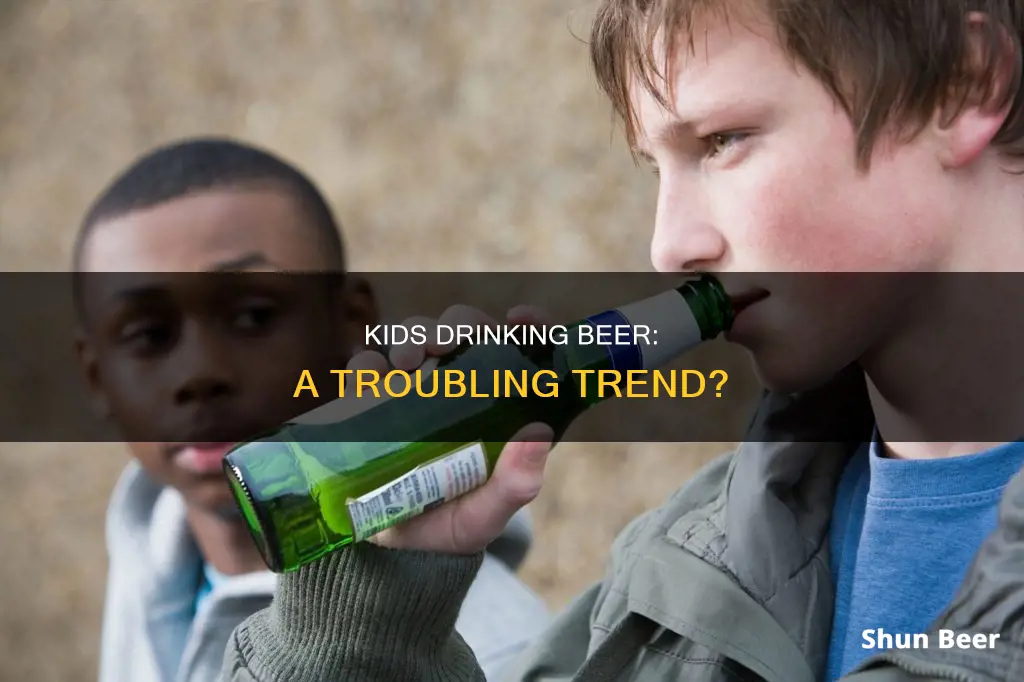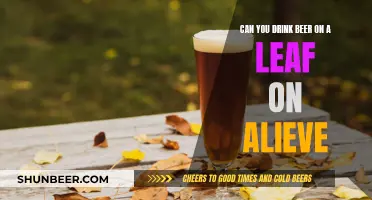
Actress Kristen Bell has received criticism for allowing her children, aged 8 and 9, to drink non-alcoholic beer. While the law varies from state to state, it is generally legal for minors to consume non-alcoholic beverages, even those with up to 0.5% ABV. However, doctors and pediatricians have warned against the practice, citing potential health risks and an increased risk of addiction and alcohol use later in life.
| Characteristics | Values |
|---|---|
| Is it legal for kids to drink non-alcoholic beer? | In the U.S., it is generally legal for minors under the age of 21 to consume non-alcoholic beverages, including non-alcoholic beer. However, this may vary by state, with some states setting the minimum age at 18. |
| Health risks | Even non-alcoholic beer could increase the risk of addiction in children and normalise drinking. |
| Parental influence | Some parents allow their children to drink non-alcoholic beer, especially in households where parents consume it or as a substitute for alcoholic beverages. |
| Marketing | The marketing of non-alcoholic and low-alcohol beers may target children or mislead parents, making these products appear like soft drinks. |
| Taste | Non-alcoholic beer has a similar taste to conventional beer, which may appeal to children. |
What You'll Learn

Non-alcoholic beer might still contain alcohol
Non-alcoholic beer is often marketed as a beverage that does not contain alcohol. However, it is important to note that the term "non-alcoholic" is sometimes misleading, as these beers may still contain small amounts of alcohol. By law, in the United States, non-alcoholic beers can contain up to 0.5% alcohol by volume (ABV). This means that while these beers will not cause intoxication when consumed in moderation, they are not entirely alcohol-free.
The amount of alcohol in non-alcoholic beers can vary, and it is essential to check the labels before consumption. Some products claim to have 0.0% ABV, while others may have higher levels of alcohol than indicated on their labels. Research has found that 29% of no- or low-alcohol beers tested had higher alcohol levels than stated, and six zero-alcohol beers sampled had alcohol levels above one percent.
The consumption of non-alcoholic beer by minors has been a topic of debate. While federal law in the United States allows minors under the age of 21 to consume non-alcoholic beverages, individual states have their own regulations. For example, Mississippi, North Dakota, and Ohio only permit the drinking of non-alcoholic beer for those 18 and older, while 14 states prohibit minors from consuming it altogether.
The potential risks of non-alcoholic beer for minors should also be considered. Pediatricians and doctors have expressed concerns, stating that it could increase the risk of addiction and normalize drinking behaviour for children. Research supports this, showing that teens who consume non-alcoholic beer have a greater interest in consuming alcoholic beverages. Additionally, the ritual of drinking beer, even if non-alcoholic, may be especially risky for children with a genetic predisposition to substance use disorder.
In conclusion, while non-alcoholic beer might be a healthier alternative to regular beer for adults, it is important to remember that it may still contain small amounts of alcohol. Parents and guardians should be aware of the potential risks and consider local and state laws before allowing their children to consume these beverages.
Beer and Diarrhea: Should You Drink or Ditch It?
You may want to see also

The legal drinking age for beer varies by state
In the United States, the legal drinking age for beer and other alcoholic beverages is 21. This was established by the National Minimum Drinking Age Act of 1984, which required states to raise their drinking age limit to 21 by 1986 or lose 10% of their federal highway funds. All 50 states complied with this directive and raised the drinking age to 21.
However, it is important to note that the Act only applies to the purchase and public possession of alcohol. The minimum age for consumption of alcoholic beverages can vary by state. While some states, such as Alabama, Arkansas, Idaho, New Hampshire, and West Virginia, have no exceptions to the federal law, many others allow minors to consume alcohol under certain circumstances. These circumstances can include the presence of parents or legal guardians, religious activities, educational purposes, lawful employment, and medical reasons.
For example, in Texas, minors are allowed to drink in licensed establishments like restaurants or bars if their parent is present and permits it. In Wisconsin, underage teens can drink in bars or restaurants as long as they are accompanied by a parent, guardian, or spouse who is 21 or older. On the other hand, states like Mississippi, North Dakota, and Ohio only allow the drinking of non-alcoholic beer for those 18 and older.
It is important to note that the laws regarding alcohol consumption for minors can be complex and vary from state to state. As such, it is essential to check the specific laws and regulations in your state or locality.
Beer Left Out: Still Drinkable?
You may want to see also

Beer consumption can lead to an increased risk of addiction
While non-alcoholic beer is often marketed as a beverage that does not contain alcohol, it is important to note that most non-alcoholic beers contain up to 0.5% alcohol by volume (ABV). This means that there is a very low amount of alcohol present in these drinks, and consuming them can increase the risk of addiction, especially in children.
Even without the alcohol content, there are physical health risks associated with children consuming non-alcoholic beer. Pediatricians say that drinking non-alcoholic beer can normalise drinking for children and increase their interest in consuming alcoholic beverages in the future. Research supports this claim, showing that teens who have consumed non-alcoholic beer are more interested in consuming alcoholic drinks. By allowing children to drink non-alcoholic beer, we plant the seed in their minds that beer drinking is acceptable and may even lead to beer drinking at a young age.
Additionally, normalising the consumption of beer products can be confusing for kids, who may not understand the difference between alcoholic and non-alcoholic beverages. This confusion can lead to dangerous consequences if a child mistakes an alcoholic beer for a non-alcoholic one.
The ritual of drinking beer, even non-alcoholic beer, can be especially risky for children who have a genetic predisposition to substance use disorder. Introducing this ritual can lead to the normalization of alcohol use and increase their risk of developing an addiction.
While the consumption of non-alcoholic drinks is unlikely to have an immediate impact on a child's health, there could be long-term consequences. The acute danger of toxicity is low, but the long-term danger is quite concerning. Therefore, it is best to refrain from giving children non-alcoholic beer to avoid increasing their risk of addiction and the potential long-term health consequences.
Beer and Sore Throats: Relief or Risk?
You may want to see also

Beer consumption can normalise drinking for children
In the US, the National Minimum Drinking Age Act of 1984 states that any beverage containing over 0.5% alcohol is considered an alcoholic drink and is prohibited for those under 21. However, this does not apply to all states, and some have their own laws permitting minors to consume non-alcoholic beverages. This inconsistency can be confusing for parents and children, and it is important to be aware of local and state laws.
The issue of normalisation is a key concern. Research has shown that teens who consume non-alcoholic beer have a greater interest in drinking alcohol. This could be due to the association of beer drinking with adulthood and independence, which may appeal to young people. By drinking non-alcoholic beer, children may feel they are taking part in an adult activity, and this could lead to an increased curiosity about alcoholic drinks.
There is also the risk of confusion between alcoholic and non-alcoholic beverages. Children may not always be able to distinguish between the two, and this could lead to accidental consumption of alcohol. In addition, the bitter taste of hops in beer may be an acquired taste for some children, and early exposure could increase the likelihood of them seeking out these flavours later in life.
The long-term impact of normalising beer consumption for children is a serious issue. While non-alcoholic beer is unlikely to cause immediate harm, it could lead to increased alcohol consumption and higher-risk drinking behaviours in the future. This is supported by research, which has found that children who sip alcohol at a young age are more likely to experience alcohol-related issues later in life.
Beer and Gallstones: Is It Safe to Drink?
You may want to see also

Beer consumption can lead to health issues
Beer consumption, even in moderate amounts, can lead to several health issues. Firstly, it can increase the risk of addiction, especially in children and adolescents. Research shows that teens who consume non-alcoholic beer have a greater interest in consuming alcoholic beverages. Normalizing the consumption of beer products can confuse minors who may not understand the difference between alcoholic and non-alcoholic drinks.
Secondly, beer consumption is associated with weight gain and an increased risk of obesity. Beer is calorie-dense and contains carbohydrates, contributing to weight gain when consumed in excess. Additionally, daily consumption of more than 500 mL of beer can increase the risk of not losing weight.
Thirdly, beer can negatively impact cardiovascular health. While low-to-moderate consumption may have some benefits, excessive intake acts as a toxin to the heart and vascular system. It can also increase the risk of heart disorders, hypertension, and cardiovascular disease.
Furthermore, beer consumption can increase the risk of developing type 2 diabetes, especially in men. Chronic and excessive alcohol intake can trigger a deterioration in glucose tolerance and alterations in signalling peptides involved in appetite regulation, leading to an increased risk of diabetes.
Lastly, beer consumption can have negative effects on bone health. While moderate consumption may increase bone mineral density, heavy drinking is associated with a higher risk of fractures. Additionally, alcohol consumption can increase the risk of falling and sustaining bone injuries.
Mowing and Drinking Beer: Is it Safe?
You may want to see also
Frequently asked questions
Generally, minors under the age of 21 can consume non-alcoholic beer, which is defined as beer with less than 0.5% ABV. However, this varies by state, with some states prohibiting minors from drinking any beer, regardless of alcohol content.
In most states, minors cannot buy non-alcoholic beer, even if they are allowed to consume it. However, there are some states that allow minors to purchase it if they are accompanied by a parent or guardian.
Yes, pediatricians say that even non-alcoholic beer could increase the risk of addiction and normalize drinking for kids. Research shows that teens who have consumed non-alcoholic beer have more interest in consuming alcoholic beverages.
There are several alternatives to non-alcoholic beer, such as soft drinks, juice, or water. It's important to offer kids healthy and age-appropriate beverage options.
This may vary depending on local laws and the restaurant's policies. In some states, minors can consume non-alcoholic beer in private establishments with parental consent, but this may not extend to public spaces like restaurants. It's important to check local regulations and individual restaurant policies.







